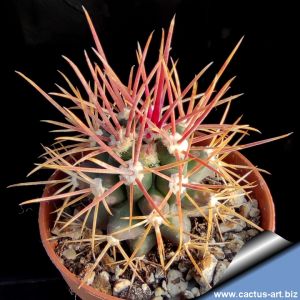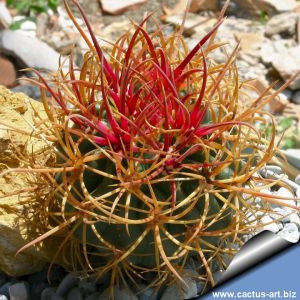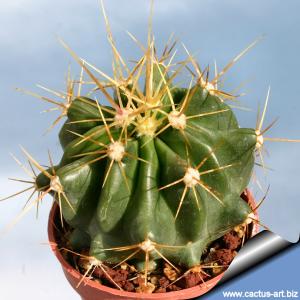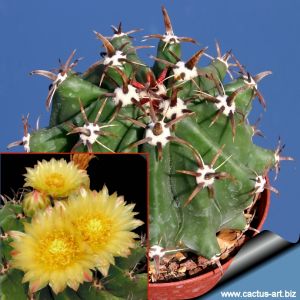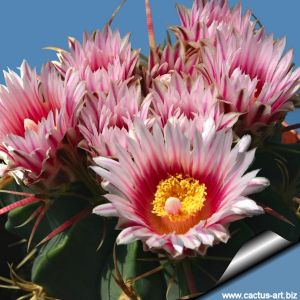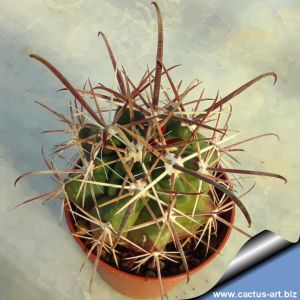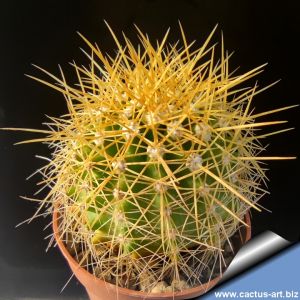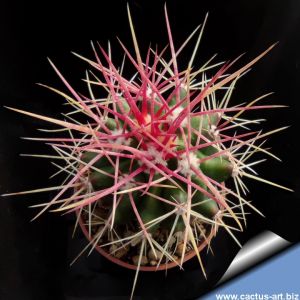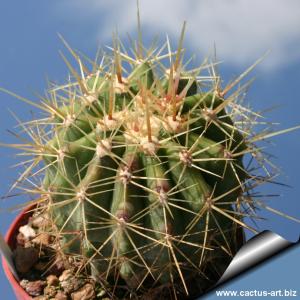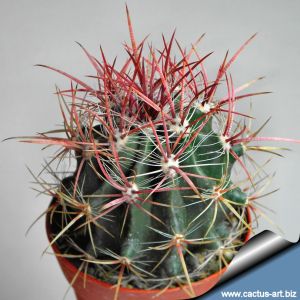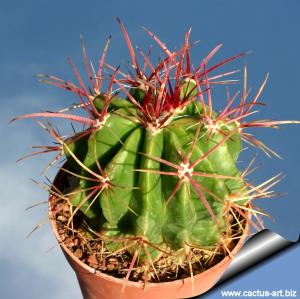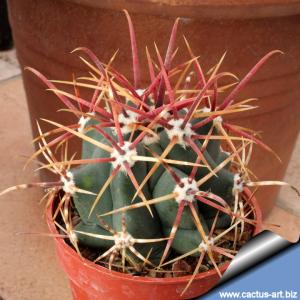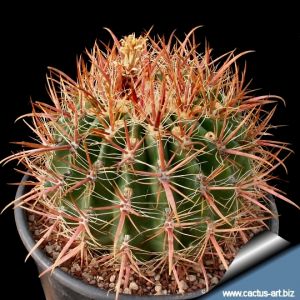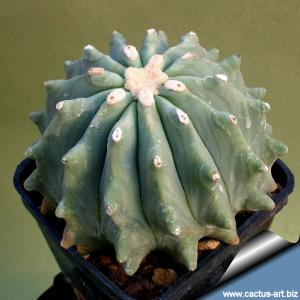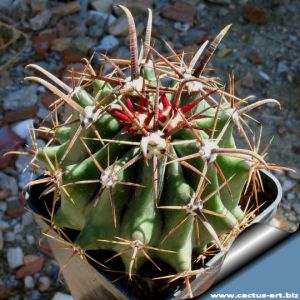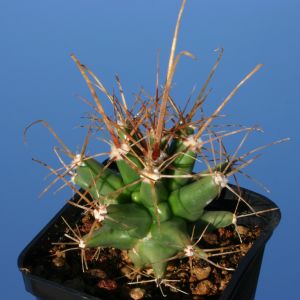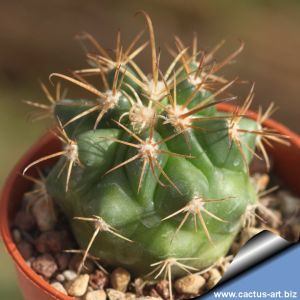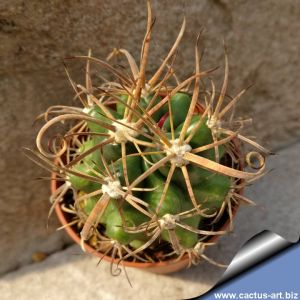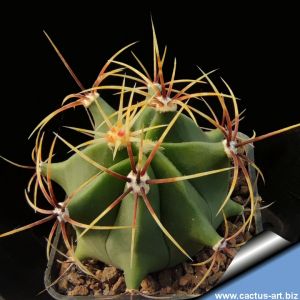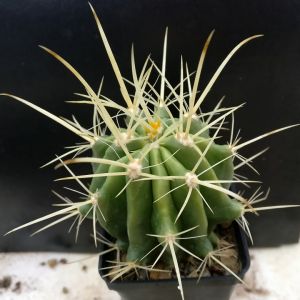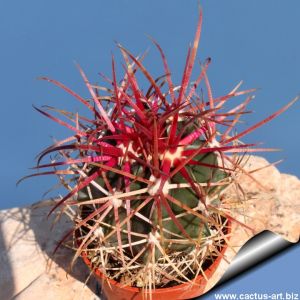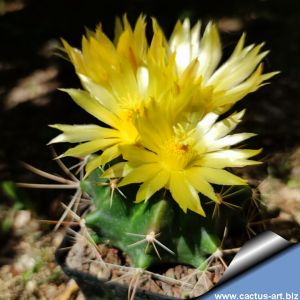-
1
Ferobergia is made by crossing Ferocactus and Leuchtenbergia. Back cross means that a Ferobergia has been pollinated back with a Ferocactus. These hybrids look more like Ferocactus, with short tubercles and hooked spines. They are quite variable.
-
2
Rare and sometimes sold as F. pottsii var. alamosanus, this Ferocactus shows relatively short, straight spines with shades from yellow to red. An uncommon species valued for its striking spine coloration.
-
3
F. chrysacanthus "rubrispinus" is a cultivated form with stunning red spines. It is one of the best and colourfull Ferocacti though quite slow growing. This plant is densely spined and because of that, will tolerate full sun. Beautiful!!!
-
4
The 'victoriensis' variety is lesser common than the standard "echidnae", it has stems that are more cylindrical and sturdy, straight central spines longer than 4,5 cm. The flowers are yellow with reddish tones.
-
5
Ferocactus horridus “brevispinus” is a solitary fast growing little barrel cactus with quite short and stocky cental spine (not enough to call it curved!) This plant becomes very nice when a bit older.
-
6
Ferocactus macrodiscus a.k.a. "Candy cactus" is a medium sized barrel cactus with a depressed stem and blue-green epidermis. Growth from seed is quite rapid and plants will flower when only a few cm across. Flowers are white with purple striped petals.
-
7
Ferocactus santamariae is a massively spined barrel cactus with stout, fierce red spines. The flower yellow or straw-yellow with a pale-red center line on the petals, and pleasant-smelling. It is a close relative of Ferocactus peninsulae.
-
8
Ferocactus schwarzii is a solitary barrel cactus with bright gold coloured spines. At a first glance the young specimens looks more like a Echinocactus grusonii than a Ferocactus. As they age the number of spines decreases to 0-2.
-
9
Red decorative spines, curved central spines. Colorfull.
-
10
F. reppenhagenii as old plants are of a small diameter, nearly cereoid growing with usually less than 13 ribs .
-
11
The Mexican fire barrel cactus is one of the most most spectacular species in this genus. Blessed with fantastic coral red spines. Notable white hairs on the areoles with age.
Syn: Ferocactus pilosus
-
12
-
13
F. viridescens subs. littoralis is a solitary barrel cactus wider than tall. The spines are dense, pink or yellowish, becoming duller by age or turning yellow or horn-colored. The flowers are greenish yellow or golden-yellow with brownish midstripes.
-
14
-
15
-
16
-
17
A large barrel cactus, taller than wide, reaching about 50 cm in height and 30 cm in diameter, with a slightly glaucous stem. Central spines are strong and hooked, starting red and turning light brown to grey with age.
-
18
Ferobergia is a horticultural intergeneric hybrid, made by crossing of a Ferocactus as a female and a Leuchtenbergia principis as a male. These hybrids are very variable, due to the intersection of characters deriving from the parents.
-
19
-
20
-
21
F. histrix is native to Mexico where the plant grows on oak forests and submontane scrub; the plant can spread up to 2600 m of altitude.
-
22
-
23
Rare form with light creamy white spines instead of red. The color of the new spines can tend to pink or yellow but then the spines lighten as they mature.
-
24
A highly ornamental colorful barrel cactus bearing intense red blooms and yellow fruits. Features stout reddish central spines tipped yellow or brown, contrasted by thin pale radial spines. New spines emerge in a brilliant red shade.
-
25
-
26
Plants obtained from seeds, variable in characteristics. The young specimens have numerous spines, but over time the spines become more sparse and shorter. Some specimens become very strange.
-
27
Ferocactus glaucescens is a medium sized, barrel cactus with greysh-blue stems. Multiple heads are produced as the plant ages and can form a very large mound. The spines are rather neatly distributed, and the unusual-looking white fruits are unmistakable.
-
28
A striking Ferocactus species from Baja California and southwestern California, growing either as a single stem or in dense clusters of up to 20. Its gently spiraled ribs and yellow-green flowers give it a distinctive charm.
-
29
-
30
Ferocactus chrysacanthus is a somewhat slow-growing species with beautiful golden spines and small stature. It is a great collector's plant.
-
31
Ferocactus acanthodes featuring red spines and yellow, white, or pink variegation on the body. Each plant is distinct, with unique patterns and colors. Rare and captivating specimens.
-
32
Plants of the mountain population. Seedlings collected in habitat.

